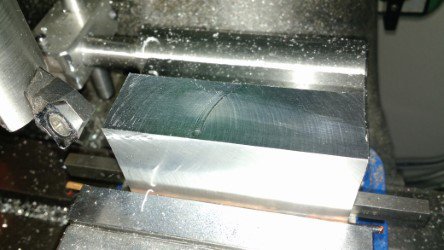-
Welcome back Guest! Did you know you can mentor other members here at H-M? If not, please check out our Relaunch of Hobby Machinist Mentoring Program!
You are using an out of date browser. It may not display this or other websites correctly.
You should upgrade or use an alternative browser.
You should upgrade or use an alternative browser.
What Would Cause This?
- Thread starter ddickey
- Start date
- Joined
- Jul 2, 2014
- Messages
- 7,594
Cutter or insert moved or chipped?
- Joined
- Nov 25, 2015
- Messages
- 8,272
what Bob said. Did you try subsequent attempts and get the same thing, at the same spot? Is this a mini mill, full size?
Did you rest and put your weight on the head ?
I assume we are talking about the 2 score marks. Not anything else about the finish?
Did you rest and put your weight on the head ?
I assume we are talking about the 2 score marks. Not anything else about the finish?
That is just one mark, the width of the cutting surface.
The rest of the cut and subsequent cuts looked normal.
I guess this would be considered a light duty full size. Grizzly G1004
I just checked the insert and it is not chipped.
This happened once before but it was some time ago.
I will check tram also on Monday just in case.
The rest of the cut and subsequent cuts looked normal.
I guess this would be considered a light duty full size. Grizzly G1004
I just checked the insert and it is not chipped.
This happened once before but it was some time ago.
I will check tram also on Monday just in case.
- Joined
- Dec 20, 2012
- Messages
- 9,422
Hmmm, you think you might have developed a BUE and it broke off on its own? That would be my guess. If the block is otherwise squaring fine then your tram is not likely to be the cause. It is also unlikely that the tool or insert is at fault if the rest of the cut went fine and all subsequent cuts are okay.
- Joined
- Dec 18, 2013
- Messages
- 87
It's when material you are cutting starts building up on the cutter. This changes the profile of the cutter.Built up edge?
What exactly is that and what would cause it?
A usual suspect (but not the only one) is lack of cutting fluid.
- Joined
- Dec 20, 2012
- Messages
- 9,422
A built up edge is when material attaches to the cutting edge of the tool. How it occurs is not clear. Some sources say the material welds onto the tip; others look at it as micro-deposition of material. However it occurs, a layer of the material being cut is deposited onto the cutting edge. This not only alters the sharpness of the tool; it also reduces back rake angles. When this occurs, chip clearance is reduced and temperatures climb even higher at the point of cut, causing more and more material to accumulate. This can cause significant finish defects. Now, if that BUE suddenly breaks off then the surface defect resolves and the cutter will function again provided the BUE didn't take a chunk of the insert with it like it usually does. This is what I think happened to your cut.
Causes of BUE are too low a cutting speed, too high a feed rate, lack of coolant (ineffective heat transfer) and changes to the tip geometry of the cutter as the BUE occurs. This happens commonly with aluminum but I've also seen it with steel alloys that can work harden.
So, clearly you can increase speed, reduce feed and use coolant. If a BUE occurs, change or revolve the insert. You can also reduce your depth of cut if you cannot increase speed enough to meet the speed requirements of the insert.
Who knew flycutting could be such an adventure, eh?
Causes of BUE are too low a cutting speed, too high a feed rate, lack of coolant (ineffective heat transfer) and changes to the tip geometry of the cutter as the BUE occurs. This happens commonly with aluminum but I've also seen it with steel alloys that can work harden.
So, clearly you can increase speed, reduce feed and use coolant. If a BUE occurs, change or revolve the insert. You can also reduce your depth of cut if you cannot increase speed enough to meet the speed requirements of the insert.
Who knew flycutting could be such an adventure, eh?


